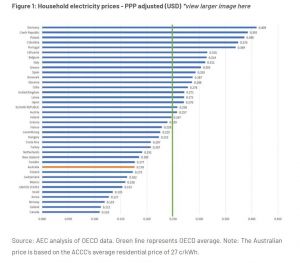Australia has been revealed as having among the lowest electricity prices in the world, according to a new report by an energy competition watchdog.
Analysis by the Australian Energy Council (AEC) found household power prices in the country ranked 10th lowest in comparison to 38 participating OECD countries.
OECD countries are those that are members of the Organisation for Economic Co-operation and Development (OECD). These are typically democratic nations like the United States, United Kingdom, Germany, France and Canada.
The AEC data shows the average price per kilowatt-hour (kWh) of electricity in Australia was equivalent to 17.6 US cents, sitting well below the average for OECD countries at 24.2 US cents/kWh.

Source: Australian Energy Council
These findings align with a separate report by the consumer watchdog which recently uncovered electricity supply costs were at their lowest in eight years.
Falling wholesale electricity prices have helped provide cheaper costs for Australians, the AEC’s Chief Executive Sarah McNamara shared.
“Consumers have been benefitting from lower wholesale prices which have been flowing through to household bills,” she said. “This assessment of how much Australian homes and businesses pay shows our electricity supply is internationally competitive, and that retailers are passing savings on to customers.
“The competitive retail market is also helping keep electricity costs down with market offers offering better value than the regulated default offers set by government.”
The highest household electricity prices were recorded in Germany, the Czech Republic and Poland, while Canada, Iceland and Norway had among the cheapest.
Australia is currently ranked 14th lowest for business electricity out of 35 OECD countries.
Compare Electricity Prices
Here are some of the cheapest published deals from the retailers on our database that include a link to the retailer’s website for further details. These are products from referral partners†. These costs are based on the Ausgrid network in Sydney but prices may vary depending on your circumstances. This comparison assumes general energy usage of 3900kWh/year for a residential customer on a single rate tariff. Please use our comparison tool for a specific comparison in your area. Our database may not cover all deals in your area. As always, check all details of any plan directly with the retailer before making a purchase decision.
Here are some of the cheapest published deals from the retailers on our database that include a link to the retailer’s website for further details. These are products from referral partners†. These costs are based on the Citipower network in Melbourne but prices may vary depending on your circumstances. This comparison assumes general energy usage of 4000kWh/year for a residential customer on a single rate tariff. Please use our comparison tool for a specific comparison in your area. Our database may not cover all deals in your area. As always, check all details of any plan directly with the retailer before making a purchase decision.
Here are some of the cheapest published deals from the retailers on our database that include a link to the retailer’s website for further details. These are products from referral partners†. These costs are based on the Energex network in Brisbane but prices may vary depending on your circumstances. This comparison assumes general energy usage of 4600kWh/year for a residential customer on a single rate tariff. Please use our comparison tool for a specific comparison in your area. Our database may not cover all deals in your area. As always, check all details of any plan directly with the retailer before making a purchase decision.
Here are some of the cheapest published deals from the retailers on our database that include a link to the retailer’s website for further details. These are products from referral partners†. These costs are based on the SA Power network in Adelaide but prices may vary depending on your circumstances. This comparison assumes general energy usage of 4000kWh/year for a residential customer on a single rate tariff. Please use our comparison tool for a specific comparison in your area. Our database may not cover all deals in your area. As always, check all details of any plan directly with the retailer before making a purchase decision.
What’s causing electricity prices to go down?
Lower wholesale electricity prices have been aided by a surge in rooftop solar, which has helped drive cheaper energy costs for Aussie bill-payers, Canstar Blue’s Energy Editor Jared Mullane said.
“As more renewable energy generation enters the grid, thanks largely to Australia’s love for solar, it plays an important role in lowering household bills for customers,” he said. “The Australian Energy Council’s report shows that retailers are generally doing the right thing by passing on savings to their customers.”
Lower fuel costs for coal and gas as well as declining networks costs have also contributed to cheaper electricity prices.
The AEC did report, however, that the cost of government reforms and environmental schemes are increasing, with small-scale renewable certificates schemes and large-scale renewable energy targets on the rise.
In the ACT alone last year, the cost of funding for renewable energy targets jumped by 133 per cent, which saw a price rise for Canberran household power bills.
Energy bills in Australia typically consist of five key charges; network costs (45%), wholesale costs (32%), environmental costs (10%), retail costs (10%) and retail margins (3%).

Image credit: Lumppini/Shutterstock.com, Australian Energy Council.


Share this article